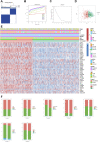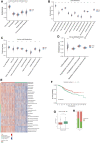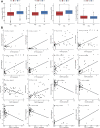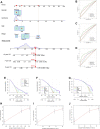Identification of a tissue resident memory CD8 T cell-related risk score signature for colorectal cancer, the association with TME landscapes and therapeutic responses
- PMID: 36685946
- PMCID: PMC9845416
- DOI: 10.3389/fgene.2022.1088230
Identification of a tissue resident memory CD8 T cell-related risk score signature for colorectal cancer, the association with TME landscapes and therapeutic responses
Abstract
Backgrounds: The tissue resident memory CD8 T cell (Trm) constitutes an important component of the local immunity. In the context of malignant tumors, mounting evidence also supports the potential anti-tumor property of this cell subset. Therefore, identification of Trm marker genes and exploration of the causative effect of Trm in shaping tumor microenvironment (TME) heterogeneity might provide novel insights for the comprehensive management of cancer patients. Methods: By dissecting a single T cell transcriptome dataset, we acquired marker genes for Trm, which were latter applied to bulk RNA sequencing profiles of two large colorectal cancer (CRC) patient cohorts downloaded from TCGA and GEO databases. First, colorectal cancer patients were divided into different Trm clusters using consensus clustering algorithm. Then, we established a Trm-related gene (TRMRG) risk score signature and tested its efficacy in predicting prognosis for colorectal cancer patients. Moreover, a sequence of rigorous and robust analyses were also carried out to investigate the potential role of Trm-related gene risk score in tumor microenvironment remodeling and therapeutic utility of it in colorectal cancer treatment. Results: A total of 49 Trm marker genes were identified by analyzing single cell RNA sequencing profiles. First, colorectal cancer patients were successfully classified into two Trm clusters with significant heterogeneity in functional enrichment patterns and tumor microenvironment landscapes. Then, we developed a Trm-related gene risk score signature and divided patients into different risk levels. High risk patients were characterized by attenuated immunogenicity, weakened sensitivity to immunotherapy, as well as adverse clinical outcomes. While low risk patients with advantages in survival exhibited increased immunogenicity, stronger metabolic activity and improved immunotherapeutic responses. Conclusion: Through combinatorial analysis of single cell and bulk RNA sequencing data, the present study identified Trm to play a non-negligible role in regulating the complexity and heterogeneity of tumor microenvironment for colorectal cancer. Moreover, the Trm-related gene risk score signature developed currently was corroborated to be tightly correlated with prognosis and therapeutic responses of colorectal cancer patients, thus exhibiting potential application value for clinical practice.
Keywords: colorectal cancer; immunotherapy; prognostic model; single cell RNA sequencing; tissue-resident memory T cells; tumor microenvironment.
Copyright © 2023 Li, Yang and Zheng.
Conflict of interest statement
The authors declare that the research was conducted in the absence of any commercial or financial relationships that could be construed as a potential conflict of interest.
Figures










Similar articles
-
A comprehensive meta-analysis of tissue resident memory T cells and their roles in shaping immune microenvironment and patient prognosis in non-small cell lung cancer.Front Immunol. 2024 Jul 8;15:1416751. doi: 10.3389/fimmu.2024.1416751. eCollection 2024. Front Immunol. 2024. PMID: 39040095 Free PMC article.
-
Characterization of stem cell landscape and identification of stemness-relevant prognostic gene signature to aid immunotherapy in colorectal cancer.Stem Cell Res Ther. 2022 Jun 9;13(1):244. doi: 10.1186/s13287-022-02913-0. Stem Cell Res Ther. 2022. PMID: 35681225 Free PMC article.
-
Molecular landscape of tumor-associated tissue-resident memory T cells in tumor microenvironment of hepatocellular carcinoma.Cell Commun Signal. 2025 Feb 11;23(1):80. doi: 10.1186/s12964-025-02070-w. Cell Commun Signal. 2025. PMID: 39934824 Free PMC article.
-
Tissue-resident memory CD8+ T cells in cancer immunology and immunotherapy.Pharmacol Res. 2020 Sep;159:104876. doi: 10.1016/j.phrs.2020.104876. Epub 2020 May 16. Pharmacol Res. 2020. PMID: 32422340 Review.
-
Resident memory T cells, critical components in tumor immunology.J Immunother Cancer. 2018 Sep 4;6(1):87. doi: 10.1186/s40425-018-0399-6. J Immunother Cancer. 2018. PMID: 30180905 Free PMC article. Review.
Cited by
-
A novel sphingolipid metabolism-related long noncoding RNA signature predicts the prognosis, immune landscape and therapeutic response in pancreatic adenocarcinoma.Heliyon. 2023 Dec 12;10(1):e23659. doi: 10.1016/j.heliyon.2023.e23659. eCollection 2024 Jan 15. Heliyon. 2023. PMID: 38173505 Free PMC article.
-
Establishment of a Seven-Gene Signature Associated with CD8+ T Cells through the Utilization of Both Single-Cell and Bulk RNA-Sequencing Techniques in Clear Cell Renal Cell Carcinoma.Int J Mol Sci. 2023 Sep 6;24(18):13729. doi: 10.3390/ijms241813729. Int J Mol Sci. 2023. PMID: 37762031 Free PMC article. Clinical Trial.
-
Tissue-Resident Memory T Cells in Gastrointestinal Cancers: Prognostic Significance and Therapeutic Implications.Biomedicines. 2024 Jun 17;12(6):1342. doi: 10.3390/biomedicines12061342. Biomedicines. 2024. PMID: 38927549 Free PMC article. Review.
-
Tissue-resident memory cells in antitumoral immunity and cancer immunotherapy.Curr Opin Immunol. 2024 Dec;91:102499. doi: 10.1016/j.coi.2024.102499. Epub 2024 Oct 31. Curr Opin Immunol. 2024. PMID: 39486215 Review.
References
LinkOut - more resources
Full Text Sources
Research Materials

